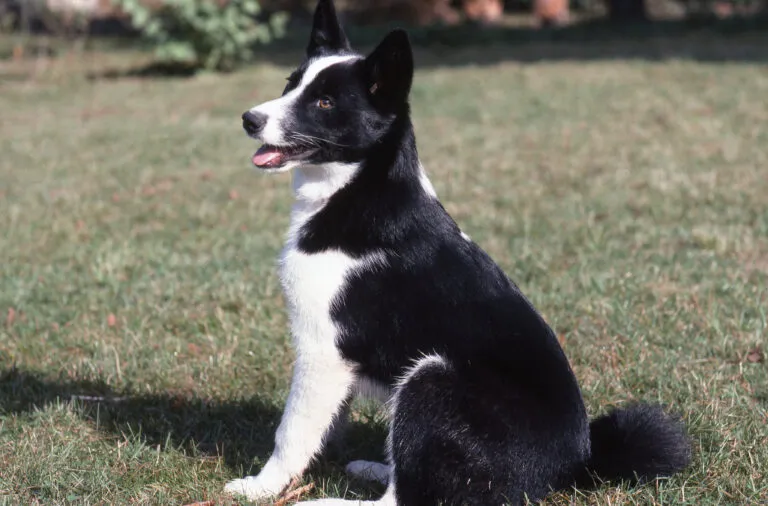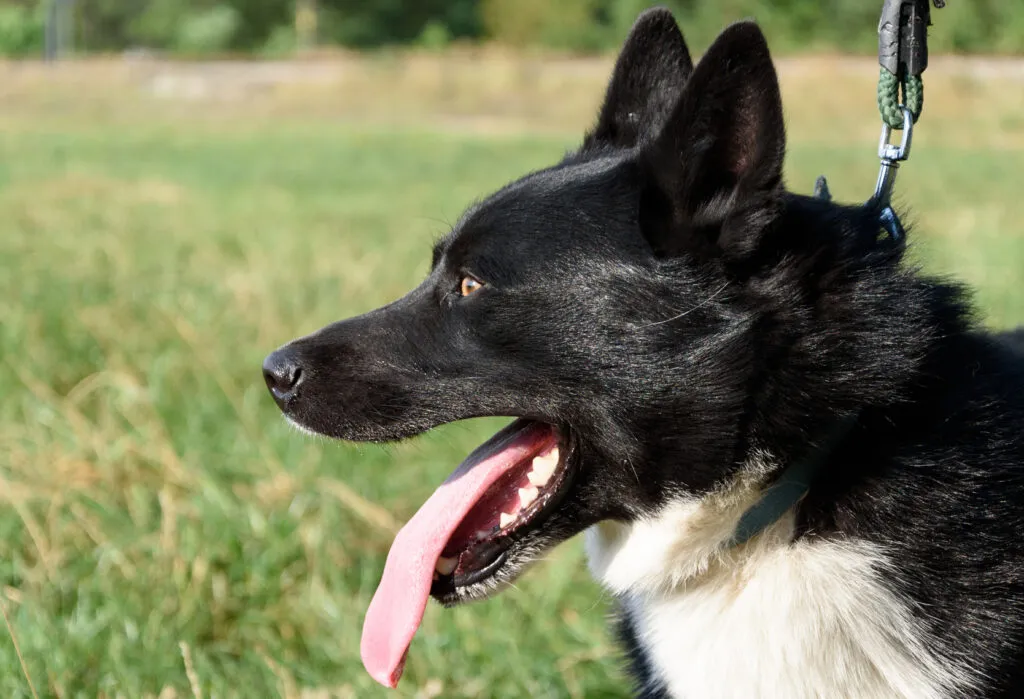Medium Size Poodle
This Finnish hunter is a prized companion in Scandinavia, especially appreciated by connoisseurs who live in the countryside and seek a highly independent mate by their side. We introduce you to this original breed from the far North.

© CallallooAlexis / stock.adobe.com
Independent and brave, the Karelian Bear Dog thrives in the wilderness and makes a loyal, alert companion with the right socialisation
This pooch bears a significant resemblance to its Russian relatives, the Laika dogs. Male dogs can reach a shoulder height of up to 60cm and weigh around 28kg. Females are slightly smaller and should not exceed 20kg.
The Karelian Bear Dog has a sturdy torso and a generally compact and dynamic build. Medium-sized, upright ears sit atop its head, and it carries a rod curved over its back, often tipped with a white spot for added charm.
Otherwise, the colour of the dense fur is typically black with white markings. The rough top coat lies tightly over a dense undercoat, which has a slight brownish hue.
This dog loves the vastness of the forests and its independence—a combination that poses certain challenges to its care, as it will seize any opportunity to roam freely. During hunts, this canine acts very independently and is supposed to corner game alone, making it a confident companion that steps up when it sees the chance.
It’s known as brave and always ready to defend its loved ones. Encounters with other dogs can be problematic without thorough socialisation, as some Karelians may show aggression towards others. However, other owners report their dogs’ great calmness and praise their sociability.
The fact is that many Karelians work together as hunting aids, so with proper socialisation, this shouldn’t be an issue. They make excellent guard dogs, reliably alerting their owners to intruders.
Despite their edges and endearing quirks, Karelians also have a softer side: they are not aggressive towards humans, enjoy cuddles at home, and love being petted by their close humans.
This dog’s favourite activity is undoubtedly hunting: long excursions through the forest and tracking game are its passion. The Karelian Bear Dog tracks the game nearly silently and, upon reaching its target, barks long and persistently to keep the game at bay until the hunter arrives.
Karelian Bear Dogs may hunt in threes, allowing them to tackle larger prey like bears. Though the breed doesn’t need to be primarily used for hunting, it can take part in dog sports—though only in activities it enjoys.
If it takes a liking, agility can be a good way for an adult Karelian to exercise. It is also a good companion for jogging or light cycling, but it’s crucial to keep its hunting instinct under control. Most of these excellent scent hounds enjoy all kinds of tracking work.
 © parampam / stock.adobe.com
© parampam / stock.adobe.com
Its independent nature requires a lot of know-how, but it should be clear from the outset to anyone considering a Karelian Bear Dog: this proud dog will never fully submit.
Its independence is such that some Karelian Bear Dogs in their homeland may disappear into the forest for days, emerging when it suits them. Harshness and shouting have no place in the training of this sensitive dog, which will otherwise withdraw.
However, with the right mix of positive reinforcement, empathy, and consistency, you can achieve good daily obedience. Early and extensive socialisation with other dogs is important from puppy age, as some Karelian Bear Dogs are known to be incompatible with other dogs, which can be problematic on daily outings.
It is a challenge to keep this dog under control and prevent it from going on independent hunting trips. Here, specialists with extensive dog experience are truly needed.
This ancient breed is known for its robustness. If you purchase it from a reputable breeder and ensure a balanced diet and – age-appropriate – plenty of exercise, your dog can live up to 13 years.
Good health also depends on what’s served in the daily food bowl. Feed your Karelian Bear Dog high-quality pet food with a high meat content and low grain levels. The energy requirement depends on the dog’s constitution and daily activity, so adjust the food accordingly and monitor the slim waistline.
Extra pounds, much like in humans, increase the risk of various health issues, such as painful joint problems. Always provide fresh water, and during long trips, carry enough water for your companion, which is also one of the heat-sensitive breeds.
Visit the vet for a check-up at least once a year and discuss the necessary vaccinations and regular deworming.
This weather-hardy dog’s fur is easy to care for. However, it sheds more during the fur change, so it may be helpful to brush it daily during this period to minimise the fur spread around the home.
Otherwise, brush it every few days—this ritual also strengthens the bond and should become a relaxed routine from puppy days. Always check the eyes, ears, and claws during this grooming session, and use special eye and ear cleaners when needed.
Claws may grow too long in dogs that mostly tread on soft ground or do not get sufficient exercise, though this is rare for this active breed, save for very old or sick dogs. Trim them using special clippers if they become too long.
Many dog owners regularly brush their dog’s teeth with dog toothpaste and a toothbrush to prevent tartar and the associated diseases, a habit to start in puppyhood. Alternatively, you can give your dog dental care snacks.
Karelian Bear Dogs need to be in the hands of experienced lovers—ideally hunters. Alternatively, they require plenty of exercise and outdoor work. Only then can a family dog even be considered. Dog experience is essential.
Prospective owners should know that this dog is only partially trainable. It’s not a dog that will subordinate itself—you should respect this as an owner but still channel its power effectively. A Karelian is unsuitable for a city apartment. Ideally, in addition to daily runs in the woods and fields, you can provide it with a secure yard.
Be cautious as this freedom-loving breed is known for its escape artistry and can jump up to two metres high. This dog bonds well with children, preferably older ones who have learned to respect animals. Cats in the same household are not a good idea, nor are rabbits or other small pets, as the northern hunter will always see them as potential prey.
While exceptions exist and friendships between well-socialised Karelians and cats can occur, you won’t get a guarantee before bringing one home. Ensuring this breed will fit well with your time, space, and experience is crucial. The Karelian Bear Dog suits connoisseurs and should never be chosen solely for its rustic appearance.
Anyone not seeking a strong character will find little delight in this four-legged housemate. Additionally, consider both the one-off (purchase from a breeder, basic equipment, travel costs) and recurring expenses (food, vet, dog tax, insurance) before bringing a Karelian home.
This breed is naturally found mainly in Scandinavia, especially Finland. Further south, there are only a few of these very specific hunting dogs. Special clubs for Nordic dogs can help you find your desired breed.
However, if you’re considering a pup from abroad, there are a few considerations. Ideally, see the puppies’ home and meet the parent dogs. Experts in Nordic dogs, whom you can contact through relevant clubs, can advise if there may be alternatives to the Karelian Bear Dog better suited to your situation and wishes or connect you with breeders if there are none expected in your country soon.
Finding adult Karelian Bear Dogs outside Scandinavia is challenging. If you wish to offer a home to an adult Karelian, seek advice from clubs for Nordic dogs that stay in touch with clubs in other countries.
Be well informed about the dog’s background, as Karelians, which should only be adopted by experienced handlers anyway, might have developed specific traits as “second-hand dogs” that you should be aware of.
Tip: also check local shelters. You might not find a Karelian, but perhaps a similarly strong-character dog looking for a new home.
We wish you much delight with your Finnish companion!
Fans of the Bearded Collie agree that those who aren't familiar with this dog breed simply have to get acquainted with it. And those who have experienced how a Bearded Collie bolts across meadows with its flowing fur, how it rolls around full of energy and joy and how it attentively and observantly takes into account its owners wishes become simply addicted to this original dog breed and its unique charm.
The Goldendoodle isn't a breed, but a pairing between Golden Retrievers and Medium or Standard Poodles. Marketed as a low-maintenance dog for allergy sufferers, this hybrid is enjoying increasing popularity amongst dog lovers, similar to the Labradoodle.